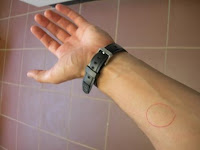“You need to be very pushy, so they call it…Pushy, but not by force. Pushy by persuasion.”
We nodded and a few of the women exchanged knowing glances.
“You may meet resistance along the way…Whatever is good will stand. Don’t give up…okay?...Don’t give up.”
These were among the last words that Dr. Joyce told us before we got back in our car and returned to Mbabane.
The five women at the table with me were at the front and center of Swaziland’s battle against malnutrition in children. They represented the two largest pediatric referral centers in the country—Mbabane Government Hospital (MGH, which I have written about before) and Good Sheppard Hospital (GSH).
Early that morning, four of the five had traveled the ~80 kilometers from MGH to GSH to share ideas about inpatient malnutrition. The fifth, Dr. Joyce, was waiting for us when we arrived.
As for me, I was the driver. A necessary sixth.
The roads between Mbabane and Siteki, though not perfect, are quite good, but one does have to mind the occasional hole, cow, goat, and oncoming traffic. (Be especially aware of older cows and minibuses, as they seem to categorically prefer death to yielding.)
Nurse Happiness (MGH’s feeding program coordinator) sat in the front seat. “I like fast cars,” she said as we pulled out of the MGH parking lot. My 1997 Opel Astra station wagon is not particularly fast, but I said, “Me too!” just for fun.
Sister Florence (MGH’s head nurse), who sat in back, took the opportunity to point out that she does not like fast cars. She also politely told me that she preferred that I keep both hands on the wheel. She was the senior MGH staff person present, so I graciously complied.
MGH’s nutritionist, Tandi, did not comment on my driving, but she probably preferred fast to slow, for she was among the most excited to see Good Sheppard’s feeding program.
“I am always afraid to come in to work on Monday,” I heard Tandi say from the back seat, “I do not like worrying how many children died over the weekend.”
At MGH, many children die over the weekend. Weekend or not, most children admitted to MGH for severe malnutrition die during their hospital stay.
This should not happen, and is a sad state of affairs.
“How many children are admitted to MGH for malnutrition?” Eileen asked.
“At least half,” Tandi responded. This week, over 30 of the total 60 hospitalized children are very malnourished.”
Eileen was the final passenger. She is a fellow UCSF-trained pediatrician and Baylor Pediatric AIDS Corps member with a long-standing interest in nutrition. Because so few starving children (many referred from our clinic) were recovering, she had organized the trip as a sort of fact-finding, idea-sharing venture. The goal was simple: to prevent unnecessary dying.
That morning, to thank me for offering to drive, Eileen had had generously bought me a café latte and loaned me a recent copy of the New Yorker. Both are incredibly hard to come by in Swaziland, so I did not turn these offerings down.
The truth is that they were entirely unnecessary. It was to be one of the most rewarding days I have had so far this year.
--
Siteki, the town where GSH is situated, rests on a small ridge overlooking the “lowveldt” of Swaziland, a few hundred meters lower in elevation than the mountain-perched, relatively temperate capital city of Mbabane, where I live. The lowveldt is a sweltering place, a flat, arid place. A parched place.
A good place for a carefully managed malnutrition program.
We arrived at GSH safely, thanks in part to the continuous “support” of several well-meaning back-seat drivers. While most of the supporters used words like “caution”, “whoa”, and “look out,” Happiness just repeated the word “faster.”
Eileen mostly just laughed, which she does frequently and most genuinely.
Once on foot, we found our way to the pediatric ward. Because we had made good time, Dr. Joyce had not yet started malnutrition rounds.
“You are here just in time,” Dr. Joyce said. Happiness and I gave each other a high five.
Dr. Joyce is a distinguished-looking woman who obviously enjoys her work. Her hair is neat, her white coat pressed, her presence commanding and her demeanor that of a well-prepared teacher who has much to teach.
In addition to one station wagon full of visitors, her audience consisted of a nurse, two nursing students, a medical student (from the US), and several mothers who listened in as she reviewed the WHO malnutrition protocols with us.
 Rounding with Dr. Joyce
Rounding with Dr. Joyce
Dr. Joyce has been at GSH for about six months. She had worked in several African countries and had run several feeding programs. She is from Zimbabwe, where her husband still lives. She often makes the 12 hour drive to see him over a long weekend.
When she arrived at GSH, the feeding program was not unlike ours in Mbabane. It needed help.
During rounds, Dr. Joyce reviewed the diagnostic criteria for severe malnutrition, the three WHO phases for treating severe malnutrition, and the logistics of feeding in a busy pediatric ward with a limited budget. We then saw each of the ~20 patients, in turn.
After each patient, Dr. Joyce had the endearing habit of making a sweeping but poignant statement, as if she had an internalized list of pithy malnutrition maxims and was awarding us for our attention by letting one slip out every so often.
After examining the first child, a gaunt three year-old with too many angles and not enough curves, she looked up and said, “When treating malnutrition, no shortcuts.”
She moved over to a child with too many curves and not enough angles, the swollen physique of kwashiorkor, or protein malnutrition. “The swollen tissues are getting better,” she told the mom as she was completing her brief exam note. “Well done.”
She paused, turned to us, and, as she shifted to the next patient, said, “Having little to work with doesn’t stop us from doing the right thing.”
Next patient.
“This does not require anything complicated.”
Next patient.
“If the mother’s do not want to work with you, you will not succeed.”
Next patient.
“If the child has HIV, fine. Put them on treatment…but always keep feeding them.”
Next patient.
“When mom’s see their babies actually getting better, they will be willing to stay.”
Next patient.
“You yourself need to be interested, and the rest of them will follow suit.”
Next patient.
Dr. Joyce pointed at two mothers discussing how to hold the baby’s cup when feeding.
“See, the mothers encourage each other. ‘Look at this milk,’ they often say. ‘It’s wonder-milk.’
In response to this, Nurse Happiness chuckled.
Dr. Joyce looked up at her.
“It’s just that I am happy to know that,” Happiness said by way of an explanation.
I chuckled too, happy that Happiness was happy.
Dr. Joyce continued, “On our malnutrition ward, mothers and malnourished children are grouped in the same section of the hospital to encourage them to talk and learn from one another.”
Happiness vigorously scribbled notes, still smiling. (MGH does not group mothers and malnourished children in the same section.)
Once the patients were all seen, we then followed Dr. Joyce from the malnutrition ward to the feeding station 10 meters away. The feeding station consists of a small table, two bowls and four buckets (three with different types of formula and one with oral rehydration solution). Above the table there was a list that reminded each mother which of the color-coded buckets they were supposed to take milk from. Indeed, this was not complicated.
 GSH feeding station
GSH feeding station
As a group, the children in the feeding program at GSH require a total of 40L of formula daily, on average.
The homemade formula costs about a dollar per liter, and is prepared in the kitchen, a few steps from the feeding station.
The kitchen was the final stop on our tour.
It was a small room, similar to a kitchen in a typical US budget apartment. It contained one sink, a counter top, an electric stove with 2 burners, a few utensils, a measuring cup, 2-3 pots and bowls, a time-keeping device, and the ingredients for the milk-based formula.
 GSH kitchen.
GSH kitchen.
Dr Joyce explained that the kitchen is run by orderlies who were trained to mix the milk appropriately, and who in turn train others as staffing needs change. The orderly on duty demonstrated to our group how to mix the milk following the WHO recipe. The milk is made round-the-clock and the kitchen is not linked to the hospital’s primary meal service.
 Kitchen tour.
Kitchen tour.
“You need to have your own kitchen,” Dr. Joyce said. Sister Florence explained that MGH did not have a kitchen for making formula, and that all formula came from the hospital’s main kitchen.
“If you wait for the [hospital] meal kitchen, tough luck.” Dr. Joyce responded. “They will make it if and when they want.”
Happiness, Florence, and Thembi knew this all to well. Children admitted to MGH frequently miss meals. The milk simply never shows up.
Eileen was busy taking photos of the GSH kitchen, for she has plans to help build a kitchen in MGH’s Ward 8. The room is already picked out, and Happiness, Florence, and Thembi’s are thrilled.
“I think we should tile the floors in the new kitchen,” she told Thembi between photographs. “It makes it look so clean.”
“We must,” agreed Florence. “But”, she said, examining the floor, “we much find the kind that fit together nicely, so that dirt does not get stuck in between.”
"We should go shopping tomorrow," Eileen said. "One of the doctors already said we could borrow his car."
Eileen, you see, is quite a planner.
The tour ended, and Eileen bought us all cold soft drinks. They did not stock juice (too expensive) and were out of brand-name Coca Cola, so I ordered a carbonated passion fruit-flavored beverage. It was vivid orange, similar in color to those little floaties that kids wear in swimming pools, the ones that fit snugly around their upper arms and keep their heads safely above water.
It tasted good, but not so much taste like passion fruit, just as watermelon-flavored gum does not actually taste like watermelon.
Still, like Swaziland’s parched lowveldt, I was hot and thirsty.
The cold drink got the job done.
 Child at entrance of GSH ward.
Child at entrance of GSH ward.




















































